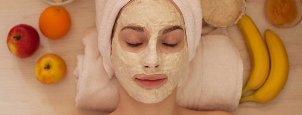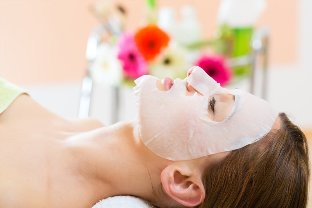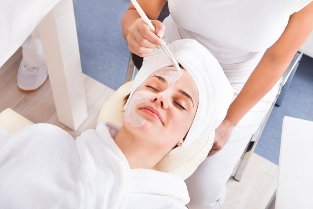
The cosmetic industry develops tons of masks, offering them for both professional salons and home use. However, homemade facial masks made with natural ingredients will always be preferable to factory-made options.
After the age of 25, girls should start taking care of their face and not only wash it with clean water, but also nourish it with various masks. Otherwise, improper care will manifest itself in the first mimic wrinkles and a noticeable deterioration in the condition of the skin.
What masks are there?
Normally, face masks are classified according to the effect they produce. There are types of skins:
- nourishing, moisturizing, toning and cleansing - they are designed for the constant care and maintenance of the skin in perfect condition;
- anti-inflammatory, whitening, anti-couperose - this group of masks successfully fights obvious skin imperfections;
- anti-aging and lifting masks: they belong to the anti-aging group and help to tighten the skin of the face.
How to determine your skin type
Before choosing a face mask, you need to determine your skin type. In classical cosmetology, it is customary to distinguish between skin type:
- bold,
- dry,
- normal,
- combined.
Since the needs of different skin types differ markedly, a homemade mask should be selected based on the type of skin you have.
As a general rule, this is not a problem, as girls are usually attentive to their appearance, and skin type can be easily determined even by looking in the mirror. However, difficulties sometimes arise. Therefore, to accurately determine your skin type at home, wash your face with normal mild soap and do not use any product on it.
After about an hour and a half, firmly place an absorbent paper towel on your face. Take a close look at the napkin and assess the degree of oily skin:
- If there is a trace of sebum on the entire surface of the napkin, it means that the skin is not tight and you have an oily skin type.
- If there are no traces left on the napkin, but the skin does not peel or feel tight, then your skin type is normal.
- If there are no greasy marks on the napkin, but you feel obvious tension, then your skin is dry.
- If in the center of the napkin your forehead, nose and chin are printed with a bold trace, and in the area of application of the cheeks and temples the skin has not left marks (dry or normal), then aSuch uneven distribution of fat content indicates a combination or combination skin type.
Nourishing facial masks at home

Nourishing masks are necessary to replenish the lack of nutrients, vitamins and microelements in the skin.
Recipe no. ° 1. Nourishing mask for oily skin (honey)
A simple composition made from 2 teaspoons of honey, 20 drops of lemon juice, and 1 tablespoon of low-fat sour cream is ideal for oily skin. Mix all the ingredients in a bowl until smooth, apply the resulting mixture on your face. Leave it on for 20 minutes to half an hour, then rinse with lukewarm water.
The mask will nourish the skin, giving it an even color, luminosity and beauty.
Recipe # 2. Nourishing mask for dry skin
To nourish dry skin at home, use the following ingredients:
- 1 egg yolk,
- 2 teaspoons of milk
- 1 half tablespoon of fine oat flakes.
Pour the oatmeal with very warm milk, let it soak a little (10-15 minutes). Beat the egg yolk with a fork and add the flakes. Apply the mass to the face and leave for 20 minutes.
This deep pore-penetrating soothing mask nourishes dry skin, relieves tightness and flaking, leaving it soft and velvety.
Recipe # 3. Nourishing mask for normal skin
It is a big mistake to think that normal facial skin does not need nutrition and care, saturation of vitamins. Nourishing mask for normal skin based on grapes that gently and carefully cares for the skin, soothes it.
Crush 6-7 grapes of any white variety (or black as a last resort), remove all seeds and skins, combine the grape mass with 1 tablespoon of sour cream. Apply the mass to your face, hold for 20-30 minutes, then rinse with warm water. The mask is so nourishing that even skin irritations can heal.
Moisturizing masks at home
Natural hydrating face masks keep your skin hydrated. Most often, hydration is necessary in summer and spring, when, under the influence of ultraviolet radiation and room temperature, part of the moisture is lost from the surface layers of the skin. Even mild dehydration can lead to decreased skin elasticity, laxity, and wrinkles.
Recipe # 4. Moisturizing masks for oily skin
The following recipe will help moisturize oily skin. Beat 1 egg white and mix with 20 ml of liquid honey until smooth. Add 1 heaping tablespoon of chopped oatmeal. Apply the mask to the face, leave it on for 20 minutes. Rinse with warm water first, then rinse your face with cold water. You can replace the flakes with potatoes or starch to help tighten your pores and nourish your skin.
Recipe no. ° 5. Moisturizing masks for dry skin
Dryness is perfectly removed with a curd mask.
Dry skin especially needs hydration, not only in summer and spring, but in general at any time of the year. Mix about 30 g of regular fat cottage cheese with 2 tablespoons of milk, warmed to body temperature. Bring the dough to a homogeneous consistency, without lumps. Apply the resulting mask on the skin for 15 minutes. Rinse with lukewarm water.
Recipe no. ° 6. Moisturizing masks for normal skin
To hydrate normal skin, use a grapefruit mask. To do this, mix the chopped pulp of two grapefruit slices with 1 egg yolk. Apply the mask on the skin for 15 minutes. Then rinse with lukewarm water.
Tonic and cleansing homemade facial masks
The cleansing and toning masks have a beneficial general strengthening effect on the skin, activate subcutaneous circulation and cleanse the pores of the face of sebaceous secretions, giving it a youthful appearance.
Recipe # 7. Toning mask for oily skin
Oily skin is perfectly toned with a white clay mask. To prepare it, dissolve 2 tablespoons of white clay in cold boiled water, add 1 egg white, 3-4 drops of lemon juice and 5 ml of honey. The resulting homogeneous batter should resemble sour cream in consistency. Apply the mask to your face and wait until it dries completely. Rinse the clay mask off with warm water as soon as it is completely dry.
Recipe no. 8. Purifying mask for dry skin
Dry skin is visibly improved and cleansed through the action of white clay. To prepare a mask at home, take 1 tablespoon of white clay, 2 times more milk and 5 ml of honey. Mix until smooth and apply to face. After 10-15 minutes, rinse off the mask and finally, after cleansing, use a moisturizer.
Recipe no. ° 9. Toning mask for normal skin
Normal skin will quickly regain its freshness and firmness with a lemon peel face mask. Stir 1 yolk and 20 ml of low-fat sour cream, add the fine zest of 1 lemon. Keep the mask on your face for no more than 30 minutes.
Homemade whitening face masks
Many girls dream of getting rid of freckles and generally bleaching their face. At home, whitening masks will help lighten age spots, even age spots.
Recipe # 10. The cucumber whitening mask is known to all for its good effect. Finely grate a medium cucumber (without seeds) and mix it with your daily nourishing cream or sour cream. Apply mass on the face for 20 minutes. Rinse with lukewarm water.
Recipe # 11. The following whitening mask turns out to be quite runny. At home, mix liquid honey and lemon juice in equal parts by volume. Soak the gauze napkins in the resulting mass, which you then put on your face. Leave it on for 15 minutes, then remove the tissues and gently rinse your face with water.
Homemade anti-aging facial masks
Over time, the skin begins to age; this is an unavoidable process. But when the first troublesome wrinkles appear, you should not be discouraged, but rather include a rejuvenation procedure in your regular skin care. Regular use of anti-aging collagen masks allows you to postpone the appearance of new age-related changes on the facial skin and smooth out existing small wrinkles.
Recipe # 12. Aloe vera rejuvenating face mask is very popular at home. Combine a tablespoon of the juice of this plant with the same amount of nourishing face cream and premium vegetable oil (preferably olive oil). Stir and apply the mask slightly warm, keep it on the face for 10 minutes.
Recipe # 13. In summer, you can make a mask with fresh banana leaves. Crush the leaves into mush and mix with honey in equal parts. If the mixture is too thick, like a gelatinous mixture, dilute it slightly with water. Keep this porridge on your face for at least 15 minutes. Remove it first with a damp swab, then rinse your face with cold water. And you don't need botulinum toxin.
Masks with lifting effect for the face at home
Fighting sagging facial skin requires constant attention from women over 30 years of age. Therefore, when the skin begins to fade, you need to arm yourself with time-tested means that will help to align the upper layer of the epidermis.
Recipe # 14. This vitamin anti-aging face mask is made at home with drugstore ingredients.
Ingredients:
- 1 heaping tablespoon pink clay
- 1 ampoule of vitamin A
- 30 ml of prepared unflavored green tea.

Gently dilute the dry clay with tea and, stirring continuously, bring the dough to a homogeneous texture. Add vitamin A and apply the whole mixture on the skin. The mask lasts 25 minutes. Regular use of this recipe restores firmness and health to the skin.
Rinse this mask with plenty of cold water.
Recipe # 15. In the egg white you can see a natural and effective lifting. Whip a protein into a stiff foam and mix with two teaspoons of soaked oatmeal. The exposure time of the mask on the skin is 15 minutes.
According to the girls, there is a lifting effect: there is a tightening of the skin.
How to properly apply a facial mask at home
Before applying any mask, you should cleanse your face of decorative cosmetics with a mild makeup remover. A cooling gel usually completes the makeup removal procedure, but you can use an additional peel.
The pre-exfoliation of dead cells is desirable for a good penetration into the skin of the face of all the substances that make up the mask, this will ensure its greater effectiveness. The scrub can also be used at home, for example according to any coffee scrub recipe.
When applying masks, follow the general rules for homemade cosmetic formulations:
- The mask application procedure cannot be performed "on the fly". Put aside all household chores and dedicate half an hour to just yourself.
- Any effective homemade facial mask should be prepared (mixed) just before use. The remaining dough cannot be stored.
- All the components of the mask should be taken of good quality, and the ingredients such as sour cream, fruit, kefir, etc. , they must be fresh.
- Before applying the mask, the face should be cleaned in the usual way. Owners of oily and combination skin probably need a preliminary exfoliating peel as well. After cleansing the skin, open your pores as much as possible, they can be steamed over a bath or a warm wet compress can be made. This will allow all the ingredients to be absorbed as much as possible and have the best impact.
- To keep hair out of the way around your face, tie it into a bun and secure it with something.
- The mask should be applied, depending on the consistency, with clean hands, a brush, gauze or cotton.
- Most masks should be applied not only to the face, but also to the neck and décolleté. An exception will be the drying masks for oily skin, since the skin in the décolleté area is much drier.
- Apply the homemade mask along the massage lines, making movements from the middle of the face to the temples. An exception is the skin directly around the eyes; no need to apply a mask.
- Rinse the mask with clean water. It is better not to remove from the tap, but to prepare in advance a jug of boiled water, cooled to body temperature.
- After rinsing off the mask, you do not need to clean your face; Gently blot excess moisture with a clean towel. On a damp face, apply a cream suitable for your skin type.
- Don't expect immediate effect from the first procedure. Homemade facial masks should be repeated regularly at intervals of 1-3 times a week. The duration of the course must be at least 3 weeks.
Precautions when using homemade masks
For girls prone to allergies, before applying the prepared mask at home, it is imperative to perform a test on the wrist or the inside of the elbow. If signs of an allergic reaction appear, take an antihistamine and do not use this product.
















































































